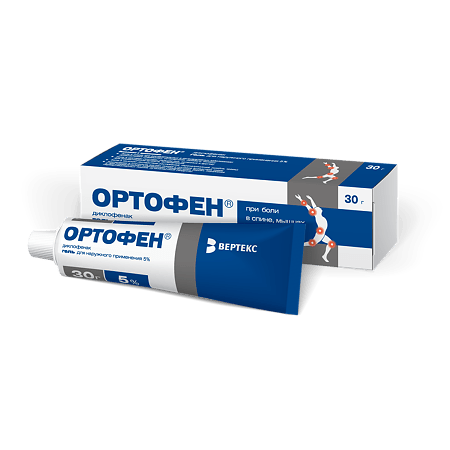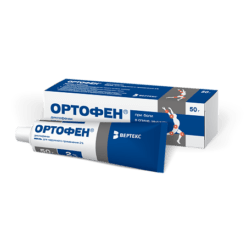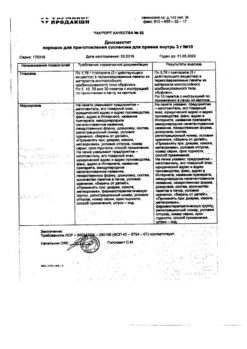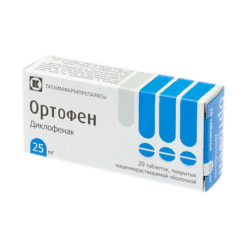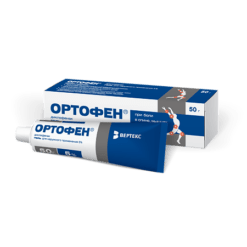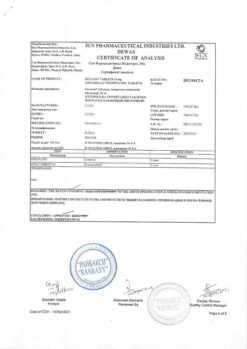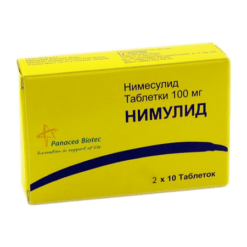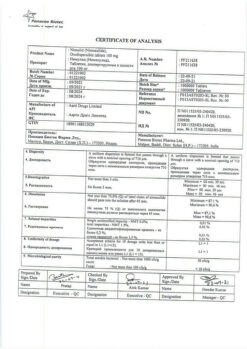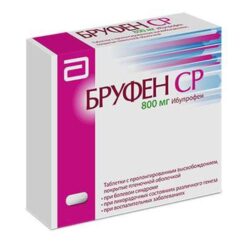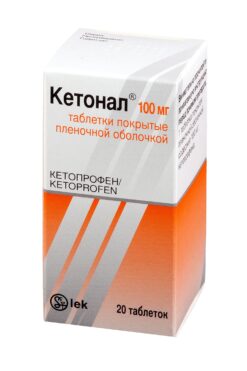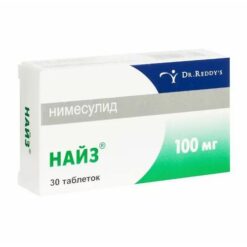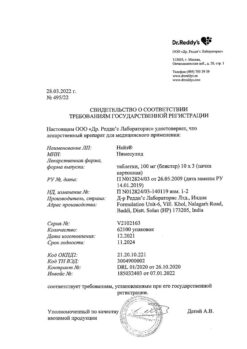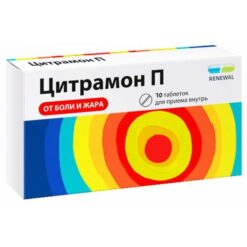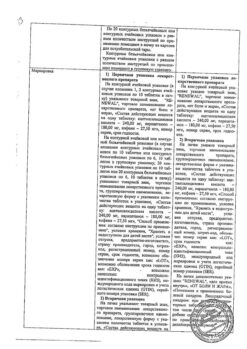No products in the cart.
Orthofen, gel 5% 30 g
€5.99 €5.32
Description
The active ingredient diclofenac is a non-steroidal anti-inflammatory drug with pronounced analgesic and anti-inflammatory properties. It inhibits indiscriminately cyclooxygenase 1 and 2 types, breaks metabolism of arachidonic acid and synthesis of prostaglandins, which are the main link in inflammation development.
Orthofen is used for pain relief and reduction of edema associated with inflammation.
It is well absorbed through the skin into the subcutaneous tissues within 5 minutes. Binding with plasma proteins is up to 99%. Penetrates into the synovial fluid, where the concentration remains unchanged for 7 h. Conjugated metabolites are excreted mainly through the kidneys, a smaller part is excreted with the faeces. Analgesic effect is achieved 30-60 minutes after application of the ointment and lasts for 2.5-5 hours, the maximum effect is developed after 1-2 hours.
Indications
Indications
Articular syndrome (rheumatoid arthritis, osteoarthritis, ankylosing spondylitis, gout), degenerative and chronic inflammatory diseases of the musculoskeletal system (osteochondrosis, osteoarthritis, periarthropathy), post-traumatic inflammation of soft tissues and the musculoskeletal system (sprains, bruises). Pain in the spine, neuralgia, myalgia, arthralgia, pain and inflammation after operations and injuries, pain with gout, migraine, algodismenorrhea, pain with adnexitis, proctitis, colic (bilious and renal), pain with infectious and inflammatory diseases of the ENT organs.
For local use: inhibition of miosis during cataract surgery, prevention of cystoid macular edema associated with removal and implantation of the lens, inflammatory processes of the eye of a non-infectious nature, post-traumatic inflammatory process in penetrating and non-penetrating wounds of the eyeball.
Pharmacological effect
Pharmacological effect
The active component diclofenac is a non-steroidal anti-inflammatory drug with pronounced analgesic and anti-inflammatory properties. By indiscriminately inhibiting cyclooxygenase types 1 and 2, it disrupts the metabolism of arachidonic acid and the synthesis of prostaglandins, which are the main link in the development of inflammation.
Ortofen is used to eliminate pain and reduce swelling associated with the inflammatory process.
Well absorbed through the skin into subcutaneous tissues within 5 minutes. Plasma protein binding up to 99%. Penetrates into the synovial fluid, where the concentration remains unchanged for 7 hours. Conjugated metabolites are excreted mainly through the kidneys, a smaller part is excreted in feces. The analgesic effect is achieved 30–60 minutes after applying the ointment and persists for 2.5–5 hours, the maximum effect develops after 1–2 hours.
Special instructions
Special instructions
Use with extreme caution in patients with a history of liver, kidney, gastrointestinal diseases, dyspeptic symptoms, bronchial asthma, arterial hypertension, heart failure, immediately after major surgical interventions, as well as in elderly patients.
If there is a history of allergic reactions to NSAIDs and sulfites, diclofenac is used only in emergency cases. During treatment, systematic monitoring of liver and kidney function and peripheral blood patterns is necessary.
Rectal use is not recommended in patients with diseases of the anorectal region or a history of anorectal bleeding. It should be used externally only on undamaged areas of the skin.
Avoid contact of diclofenac with the eyes (except for eye drops) or mucous membranes. Patients using contact lenses should use eye drops no earlier than 5 minutes after removing the lenses.
Not recommended for use in children under 6 years of age.
During treatment with dosage forms for systemic use, alcohol consumption is not recommended.
Impact on the ability to drive vehicles and operate machinery
During the treatment period, the speed of psychomotor reactions may decrease. If your vision becomes blurred after using eye drops, you should not drive a car or engage in other potentially hazardous activities.
Active ingredient
Active ingredient
Diclofenac
Composition
Composition
100 g of gel contains:
Active substance:
diclofenac sodium – 5.0 g.
Excipients:
propylene glycol – 5.0 g,
ethanol 95% (ethyl alcohol 95%) – 30.0 g,
hyaetellose (hydroxyethylcellulose) – 2.5 g,
purified water – up to 100.0 g.
Contraindications
Contraindications
Erosive and ulcerative lesions of the gastrointestinal tract in the acute phase, “aspirin triad”, hematopoietic disorders of unknown etiology, hypersensitivity to diclofenac and components of the dosage form used, or other NSAIDs.
Side Effects
Side Effects
Allergic skin reactions (burning, redness); with long-term use and/or use in large quantities – systemic side effects characteristic of NSAIDs.
Interaction
Interaction
When used simultaneously with diclofenac, antihypertensive drugs may weaken their effect.
There are isolated reports of the occurrence of seizures in patients taking NSAIDs and quinolone antibacterial drugs simultaneously.
When used simultaneously with GCS, the risk of side effects from the digestive system increases.
With simultaneous use of diuretics, the diuretic effect may be reduced. When used simultaneously with potassium-sparing diuretics, it is possible to increase the concentration of potassium in the blood.
When used simultaneously with other NSAIDs, the risk of side effects may increase.
There are reports of the development of hypoglycemia or hyperglycemia in patients with diabetes mellitus who used diclofenac simultaneously with hypoglycemic drugs.
When used simultaneously with acetylsalicylic acid, the concentration of diclofenac in the blood plasma may decrease.
Although clinical studies have not established the effect of diclofenac on the action of anticoagulants, isolated cases of bleeding have been described with the simultaneous use of diclofenac and warfarin.
With simultaneous use, it is possible to increase the concentration of digoxin, lithium and phenytoin in the blood plasma.
The absorption of diclofenac from the gastrointestinal tract is reduced when used simultaneously with cholestyramine, and to a lesser extent with colestipol.
With simultaneous use, it is possible to increase the concentration of methotrexate in the blood plasma and increase its toxicity.
With simultaneous use, diclofenac may not affect the bioavailability of morphine, however, the concentration of the active metabolite of morphine may remain elevated in the presence of diclofenac, which increases the risk of developing side effects of the morphine metabolite, incl. respiratory depression.
When used simultaneously with pentazocine, a case of the development of a grand mal seizure has been described; with rifampicin – a decrease in the concentration of diclofenac in the blood plasma is possible; with ceftriaxone – excretion of ceftriaxone with bile increases; with cyclosporine – increased nephrotoxicity of cyclosporine is possible.
Overdose
Overdose
Symptoms: Due to low systemic absorption when applying the gel, an overdose is unlikely. In case of accidental ingestion, systemic adverse reactions may develop.
Treatment: Gastric lavage, induction of vomiting, activated charcoal, forced diuresis, symptomatic therapy. Dialysis is not effective due to the high degree of protein binding of diclofenac (about 99%).
Storage conditions
Storage conditions
At a temperature not exceeding 25 °C. Keep out of the reach of children.
Shelf life
Shelf life
2 years.
Manufacturer
Manufacturer
Vertex, Russia
Additional information
| Shelf life | 2 years. |
|---|---|
| Conditions of storage | At a temperature not exceeding 25 °C. Keep out of reach of children. |
| Manufacturer | Vertex, Russia |
| Medication form | gel for external use |
| Brand | Vertex |
Other forms…
Related products
Buy Orthofen, gel 5% 30 g with delivery to USA, UK, Europe and over 120 other countries.

